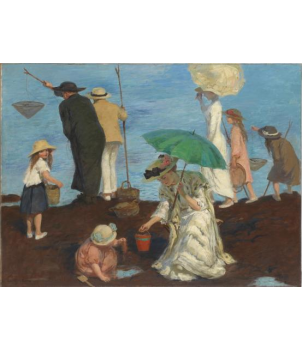Over the long weekend, I took a trip to the National Gallery of Victoria to check out the Rupert Bunny exhibition.
I was surprised to learn that the artist was originally a Melbournian, born in St Kilda, Victoria in 1864. He travelled to England in 1884 to study at Calderon’s art school in London and married a former art student and model, Jeanne Heloise Morel, in 1902.
He lived with his wife in France until 1911 and he became one of the most successful expatriate artists of his generation.
After his wife died in 1933, he returned permanently to Australia and settled in South Yarra, Victoria.
As I took in the collection of his works, I understood why he achieved such critical acclaim during his lifetime and lasting until this day. The exhibition follows Bunny’s extraordinary life and art, from Melbourne to Paris and back again. His paintings are vibrant and colourful and his use of light and shade is incredible. I could almost feel the sun on my own face and breeze in my hair as I gazed into the summer garden scenes he was so fond of capturing on canvas.
Renowned as a superb colourist and fine draughtsman, with a strong interest in rhythmic composition, Bunny was inspired by a range of late century tendencies, most particularly Symbolism with its affinity to the life of the imagination. Bunny crafted individualised statements from such influences, in imaginative tableaux which range from magnificent Salon-endorsed mythologies, to vibrant decorative allegories and the Belle Epoque paintings of Parisian leisure for which he is most widely celebrated.
In Bunny’s Belle Époque works, like ‘A summer morning‘ or ‘Beautiful afternoon in Royan’ (both 1908), we see compositional similarities to Russia’s Critical Realists, but none of their biting commentary. Bunny didn’t seek to expose the injustices of his time, but concentrated on discovering its beauty. It is this that makes him the target of much criticism as his work seems so mired in the languor of his era that we may find ourselves fretfully tempted to ask the subjects of his paintings to get up occasionally and perhaps do something. However it is exactly this peacefulness and escapism that I so enjoyed immersing myself in.
This exhibition traces Bunny’s career from his early mythologies (fauns and nymphs being languid) up to the Belle Époque era (fashionable Parisians being languid).
Ultimately we must thank Bunny for his having captured for us the essence of the last era before we the scientific took over and simplicity was forgotten. During his time, world wars hadn’t been contemplated, television didn’t drown out conversation, a mobile phone never rang on a beach. His works celebrate this innocence.
Organised by the Art Gallery of New South Wales, it is the first major exhibition of Bunny’s work since 1991 and includes over one hundred paintings, drawings and monotypes, some of which have never been seen before in Australia, where Bunny’s life started and ended.
The exhibition takes place from 26 Mar 2010 – 04 Jul 2010 at The Ian Potter Centre: NGV Australia at Federation Square.
For more information go to http://www.ngv.vic.gov.au/whats-on/exhibitions/exhibitions/rupert-bunny-artist-in-paris


